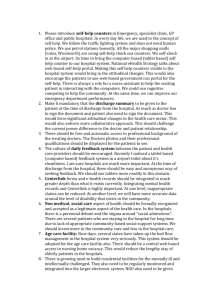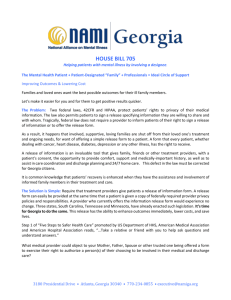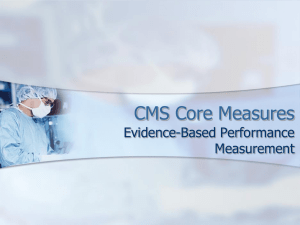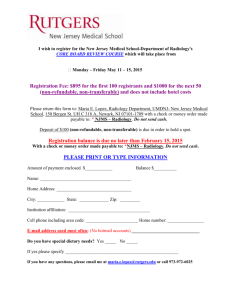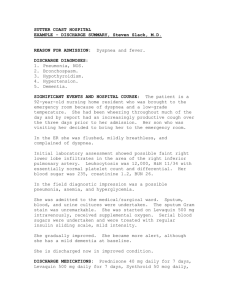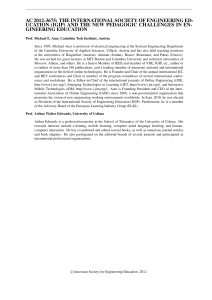December 2011, Issue 12 - Division of Hospital Medicine
advertisement
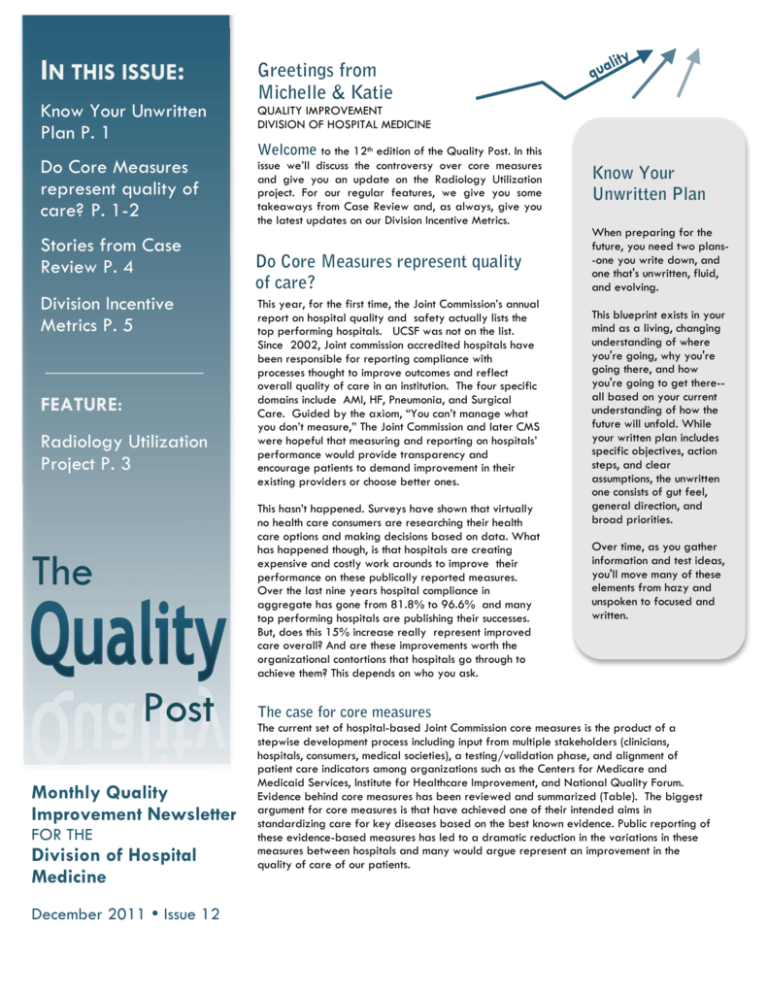
IN THIS ISSUE: Know Your Unwritten Plan P. 1 Do Core Measures represent quality of care? P. 1-2 Stories from Case Review P. 4 Division Incentive Metrics P. 5 FEATURE: Radiology Utilization Project P. 3 Greetings from Michelle & Katie QUALITY IMPROVEMENT DIVISION OF HOSPITAL MEDICINE Welcome to the 12th edition of the Quality Post. In this issue we’ll discuss the controversy over core measures and give you an update on the Radiology Utilization project. For our regular features, we give you some takeaways from Case Review and, as always, give you the latest updates on our Division Incentive Metrics. Do Core Measures represent quality of care? This year, for the first time, the Joint Commission’s annual report on hospital quality and safety actually lists the top performing hospitals. UCSF was not on the list. Since 2002, Joint commission accredited hospitals have been responsible for reporting compliance with processes thought to improve outcomes and reflect overall quality of care in an institution. The four specific domains include AMI, HF, Pneumonia, and Surgical Care. Guided by the axiom, “You can’t manage what you don’t measure,” The Joint Commission and later CMS were hopeful that measuring and reporting on hospitals’ performance would provide transparency and encourage patients to demand improvement in their existing providers or choose better ones. This hasn’t happened. Surveys have shown that virtually no health care consumers are researching their health care options and making decisions based on data. What has happened though, is that hospitals are creating expensive and costly work arounds to improve their performance on these publically reported measures. Over the last nine years hospital compliance in aggregate has gone from 81.8% to 96.6% and many top performing hospitals are publishing their successes. But, does this 15% increase really represent improved care overall? And are these improvements worth the organizational contortions that hospitals go through to achieve them? This depends on who you ask. The Post Monthly Quality Improvement Newsletter FOR THE Division of Hospital Medicine December 2011 Issue 12 Know Your Unwritten Plan When preparing for the future, you need two plans-one you write down, and one that's unwritten, fluid, and evolving. This blueprint exists in your mind as a living, changing understanding of where you're going, why you're going there, and how you're going to get there-all based on your current understanding of how the future will unfold. While your written plan includes specific objectives, action steps, and clear assumptions, the unwritten one consists of gut feel, general direction, and broad priorities. Over time, as you gather information and test ideas, you'll move many of these elements from hazy and unspoken to focused and written. The case for core measures The current set of hospital-based Joint Commission core measures is the product of a stepwise development process including input from multiple stakeholders (clinicians, hospitals, consumers, medical societies), a testing/validation phase, and alignment of patient care indicators among organizations such as the Centers for Medicare and Medicaid Services, Institute for Healthcare Improvement, and National Quality Forum. Evidence behind core measures has been reviewed and summarized (Table). The biggest argument for core measures is that have achieved one of their intended aims in standardizing care for key diseases based on the best known evidence. Public reporting of these evidence-based measures has led to a dramatic reduction in the variations in these measures between hospitals and many would argue represent an improvement in the quality of care of our patients. The case measures against core While core measures may be evidence based, they require a tremendous amount of resources both to improve compliance as well as to document, abstract and report these mandated performance measures. It is estimated that the process takes ~22 minutes per case, which amounts to 400,000 person hours each year by US hospitals. Achieving top performance also means investments in care redesign, documentation improvement and data integration systems. The developers and supporters of core measures believe that committing these resources would result in more standardized, efficient care that would in the end reduce longitudinal costs for organizations. However, to achieve high levels of compliance core measure processes must be implemented successfully across broad populations. This challenge may encourage providers to simply “check a box” rather than providing improvements in care. There is some data to suggest our increase in core measures compliance has not improved outcomes. In a recent commentary published in JAMA, Fonarow writes, “However, in marked contrast with expectations, available data suggest that 30-day and 1-year mortality (unadjusted or adjusted) following heart failure admission was relatively constant over this 6-year period, as were heart failure rehospitalizations (unadjusted or adjusted) and heart failure costs among the Medicare population. The concern is that hospitals may have circumvented the true purpose of the measures by adopting a “check boxes” mentality without actually providing the care process in a way meaningful for patients.” Where do we go from here? Core measures' and safety goals' level of evidence and impact on patient outcomes Core measure/safety goal Level of Impact on patient outcomes† evidence Myocardial infarction Beta-blockers I 18% mortality reduction Aspirin I 25% reduction in stroke, myocardial infarction, or death ACE inhibitors if EF <40% I 20% mortality reduction Smoking cessation II-2 40% mortality reduction (one life saved for every 13 patients who quit) Lipid therapy I 16% mortality reduction and 25% reduction in recurrent myocardial infarction ACE inhibitors/ARBs I 20% mortality reduction Smoking cessation II-2 Improved quality of life Discharge education I 10% mortality reduction, 25% reduction in readmission Heart failure Community-acquired pneumonia Timely antibiotics II-2 15% mortality reduction Blood cultures prior to first antibiotics II-2 40% of cases of severe pneumonia antibiotic selection adjusted based on blood culture results Smoking cessation II-2 50% reduction in individual's risk of developing pneumonia Pneumovax II-2 40% reduction in pneumococcal pneumonia Flu vaccination II-2 50% reduction in pneumonia, hospitalization, or death Surgical site infection prevention Surgical infection II-2 Doubling in mortality Hair shaving I Doubling of surgical infections Poor glucose control II-2 Doubling of surgical infections Surgical site infection bundle§ II-3 27% reduction in surgical infections * Adapted from Masica et al. Linking Joint Commission inpatient core measures and National Patient safety Goals with evidence, Baylor Medical Center Proceeduings, 2009 At UCSF our performance on core measures has improved significantly since we started reporting them, and care, especially that for our HF patients has improved dramatically. But we are not at 100%, despite our improved outcomes on readmissions and patient education. Financial incentives to improve performance and increased transparency of our data is driving our benchmark performance from >90% to achieve perfect performance. The fear is that the incremental effort needed to achieve 100% compliance may not translate into an incremental outcome benefit for our patients and may take resources away from other areas of improvement. In our care of these patients, and all patients we will continue to strive for true quality improvement: whether that means achievement of perfect adherence to core measures or increasingly those linked to real outcomes for the population, such as CMS 30-day riskstandardized mortality and readmission measures. With increased focus on more broad outcomes measures, the hope is that l motivate hospitals to focus on all processes of care, instead of a select few under intense scrutiny. Radiology Utilization at Parnassus • In 2010 alone, our Medicine Service charged more than $9 million (!) for CT scans and X-rays. And this number doesn’t even include patients with ICU stays • As a comparison, 30-40% of medical services at academic health centers order fewer tests than our medicine service, and 90% order fewer CXRs. Six months ago, in our June edition of the Quality Post, we highlighted the increasing importance of the Value Equation (Value = Quality/Cost) in the changing landscape of health care reform. For hospital medicine this means a heightened awareness of the labs we order, the imaging we request and our length of stay. One area in particular, diagnostic testing, has ample opportunity for improvement as unnecessary and expensive diagnostic tests can contribute to wasteful spending if the tests don’t change management or improve patient outcomes. The Impact of a Radiology Utilization Campaign on Test Ordering Practices This month we will highlight a specific value-based initiative that we began implementing in DHM in October 2011. Purpose: To evaluate the impact of an educational awareness campaign on radiology test ordering practices. Description: Raised awareness about radiology cost and utilization through educational interventions targeting trainees and attending on the medicine service • Posters & flyers with # and cost of radiology tests, benchmarks, practical tips to guide ordering patterns • “Radiology Utilization” curriculum and facilitation guide for attending to use during teaching rounds Initial Findings: During the first month, significant reductions were noted in 5 out of the 6 radiology tests evaluated. We compared these to our baseline data from the previous two years. Baseline Period (2 years) Oct 2009 – Sept 2011 Intervention Period (1 month) Oct 2011 X-­‐Ray Body 0.15 (n=3,192) X-­‐Ray Chest 0.32 (n=6,716) CT-­‐ Head 0.06 (n=1,199) CT-­‐ Body 0.17 (n=3,565) U/S 0.06 (n=1,208) MRI 0.05 (n=999) 0.14 (n=96) 0.27 (n=188) 0.08 (n=53) 0.14 (n=99) 0.05 (n=32) 0.04 (n=30) % Change -­‐9.73% -­‐18.59% 25.03% -­‐19.65% -­‐24.19% -­‐11.37% Thank you to all of the attendings on service in October and November for helping make this project a success. For attendings on service in February and March, please look for our next facilitator guides about radiation exposure associated with these tests. Stories from Case Review: This month we bring you two of our most important cases from the case review files, and the lessons we learned from them. Insulin transitions in Care: Knowing our resources… 93 year old man with multiple medical issues including DM, who was admitted for a CHF exacerbation. During the hospitalization the patient had an episode of hypoglycemia. His insulin regimen was subsequently reduced and teaching was done by the diabetes nurse educator. He was discharged on a regimen of 18 units glargine at bedtime and 2 units Aspart TID with meals. The patient’s pharmacy received the new prescription on the day of discharge. Aspart was accidentally not transcribed by the pharmacy, and was therefore not dispensed. As the patient’s wife had not obtained Aspart from the pharmacy, she gave the patient his prior, higher insulin dose in the form of Lispro. When she noted him becoming hypoglycemic, she tried to feed him, precipitating aspiration PNA, for which he was admitted to SFGH and passed away. Many great things were done for this patient but this case is a reminder of the fragility of our diabetic patients. Reminders for Diabetic resources: 1. Diabetic Nurse Educator: Mary Sullivan (on pager box) is a great resource to help determine a home regimen for patients and provide them counseling. Pharmacists are also available for a “discharge pharmacy consult” and will write a medication schedule and go over it with your patients. Call her early so that she has time to do teaching with patients and families. 2. Insulin Prescription: With all the types of insulin out there, it’s best to confirm availability with the outside pharmacist. Remember though we use Lantus and Aspart in the hospital. The patient may have and use other types of insulin at home resulting in confusion and error. 3. Home Care for Insulin Dependent Diabetics: Many patients are sufficiently weakened after a hospitalization to meet criteria for homecare. Home is the best place to do true medication reconciliation and observe how patients take medications at home. For more active patients, there is a diabetic resource clinic, staffed by NPs for UC patients. 4. Teachback: Despite extensive education on discharge the patient’s wife returned to the old insulin regimen in a moment of ambiguity. Using teach back can help ensure patient & caregiver understanding of discharge instructions. Full Code, but “call us before you press the button” A 74 year old Samoan-speaking woman was brought to the to the ED with chest pain and AMS. On a recent admission she had been diagnosed with metastatic lung cancer and had refused all medical interventions, wishing to return home to be with her family. On this admission, she was altered and the family who brought her in wished to defer a code discussion until her favorite granddaughter arrived from Hawaii in 12 hours. Her EKG showed a probable third degree heart block. Given her previous wishes against aggressive care, she was admitted to 14M in anticipation of eventually being made DNR/DNI, but she was kept as FULL CODE. The night resident and hospitalist made a concerted effort to communicate with the nurses regarding the unusual circumstances. The nurses remained worried that should they see a concerning arrhythmia on the monitor, she would not be in the right place for necessary interventions like pacing and ultimately filed an incident report. She was discharged with hospice the following day. What would you do? A critically ill patient with an ambiguous code status is a challenge for all providers. Though this patient’s wishes were known from past admissions, a language barrier and a family reluctant to make decisions for their altered relative made determination of code status on this admission impossible. Frequent and clear communication between all providers caring for the patient is essential to ensure the patients wishes are met. Ultimately, in reviewing this case with the residents, they decided that the safest course for this patient would have been admission to the ICU to be able to provide her goals of all available medical interventions. Progress towards Goal Division Incentive Goals PCPs reported receiving information at discharge >80% of the time Communicate with UCSF PCP >80% of time July Baseline Data August 6% Dec 22% 55% 80% PCP Communication at Discharge 30% 19% 27% Aug n=60 Sept n=81 Oct n=71 Achieve HCAHPS: Communication with Doctors Top Box score above 82% 100% QI S CHOOL PCP Communication at DIscharge 80% 71% Nov n=35 FY 2011 HCAHPS Top Box Score: 79% Sept Oct 92% 86% Nov Dec MD Communication Sum MD Explanation 70% M&M type format for Quality Cases: Dec 19 Jan 20 F ACULTY QI L UNCHES DEC 12: Pneumonia Core Measures JAN 9: Medicine Discharge Coordinators Target 60% June July n=20 Aug n=20 Sept n=8 Achieve MD hand hygiene rates of >85% on all Medicine Floors: 14L, 14M, MTZ 5E/W Sept July August 86% August 54% Oct n=12 2010 MD HH Compliance: 7 of 10 recent months 89% 88% Schedule follow up appointments for 80% UCSF primary care patients discharged home (2 wks) and SNF (1 month) 59% 7of 10 recent months HCAHPS MD Communication Score 80% July Break until spring R ESIDENT QI L UNCHES 90% 89% OF EVENTS Nov 100% 80% 60% 40% 20% 0% 78% CALENDAR Oct 40% August 7of 10 recent months Sept 30% July FY 2012 Oct Nov 97% 96% June 2010: DGIM PCP follow up 29% Dec 6 of 8 recent months: October start Sept Oct Nov Dec 83% 83% 81% C ENTER FOR H EALTH P ROFESSIONS No upcoming events
